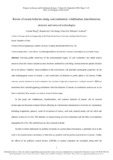JavaScript is disabled for your browser. Some features of this site may not work without it.
| dc.contributor.author | Wang, Chunbo | |
| dc.contributor.author | Liu, Huimin | |
| dc.contributor.author | Zhang, Yue | |
| dc.contributor.author | Zou, Chan | |
| dc.contributor.author | Anthony, Edward J. | |
| dc.date.accessioned | 2018-04-19T17:45:11Z | |
| dc.date.available | 2018-04-19T17:45:11Z | |
| dc.date.issued | 2018-04-17 | |
| dc.identifier.citation | Chunbo Wang, Huimin Liu, Yue Zhang, Chan Zou, Edward J. Anthony, Review of arsenic behavior during coal combustion: Volatilization, transformation, emission and removal technologies, Progress in Energy and Combustion Science, Volume 68, September 2018, Pages 1-28 | en_UK |
| dc.identifier.issn | 0360-1285 | |
| dc.identifier.uri | https://doi.org/10.1016/j.pecs.2018.04.001 | |
| dc.identifier.uri | http://dspace.lib.cranfield.ac.uk/handle/1826/13156 | |
| dc.description.abstract | Growing public awareness of the environmental impact of coal combustion has raised serious concerns about the various hazardous trace elements produced by coal firing. Arsenic deserves special attention due to its toxicity, volatility, bioaccumulation in the environment, and potential carcinogenic properties. As the main anthropogenic source of arsenic is coal combustion, its behavior in power plants is of concern. Unlike mercury, arsenic behavior in coal combustion has not been subjected to systematic, in-depth research. Different researchers have reached opposing conclusions about the behavior of arsenic in combustion systems and, as yet, there is relatively little research on arsenic removal technologies. In this paper, the volatilization, transformation, and emission behavior of arsenic and its removal technologies are discussed in depth. Factors affecting the volatilization characteristics of arsenic are summarized, including temperature, pressure, mode of occurrence of arsenic, coal rank, mineral matter, and the sulfur and chlorine content of the fuel. The behavior of arsenic during oxy-fuel combustion and the effect of combustion atmosphere (O2, CO2, SO2 and H2O(g)) are also reviewed in detail. In order to better understand the pathways of arsenic in a power plant environment, a particular focus in this work is the transformation mechanism of ultra-fine ash particles and the partitioning behavior of arsenic. Finally, the effects of air pollution control devices (APCDs) on arsenic emissions are examined, along with the effectiveness of flue gas arsenic removal technologies with different kinds of adsorbents, including calcium-based adsorbents, metal oxides, activated carbon, and fly ash. | en_UK |
| dc.language.iso | en | en_UK |
| dc.publisher | Elsevier | en_UK |
| dc.rights | Attribution-NonCommercial-NoDerivatives 4.0 International | * |
| dc.rights.uri | http://creativecommons.org/licenses/by-nc-nd/4.0/ | * |
| dc.subject | Arsenic | en_UK |
| dc.subject | Coal combustion | en_UK |
| dc.subject | Volatilization | en_UK |
| dc.subject | Transformation | en_UK |
| dc.subject | Emission | en_UK |
| dc.subject | Removal | en_UK |
| dc.title | Review of arsenic behavior during coal combustion: Volatilization, transformation, emission and removal technologies | en_UK |
| dc.type | Article | en_UK |
Files in this item
The following license files are associated with this item:
This item appears in the following Collection(s)
-
Staff publications (SWEE) [2825]

